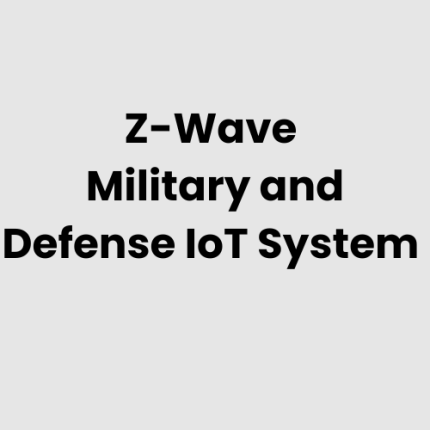Description
Technical Architecture of Z-Wave Enabled Aviation IoT System
The Z-Wave Enabled Aviation IoT System is designed to improve operational efficiency, safety, and security within aviation environments. The system is built on a robust architecture that includes edge devices, gateways, cloud integration, and sensors. It utilizes low-power, high-reliability Z-Wave wireless communication for connecting a wide range of IoT devices like environmental sensors, access control devices, and security monitoring tools. The system integrates seamlessly with existing airport management systems, providing real-time data analytics for better decision-making.
Hardware of Z-Wave Enabled Aviation IoT System
- Z-Wave Sensors: Motion, temperature, humidity, and air quality sensors for monitoring the environment and safety conditions.
- Z-Wave Actuators: Devices that control lighting, HVAC, and access points to optimize energy usage and security.
- Gateways and Controllers: Centralized hubs that facilitate communication between Z-Wave devices and airport systems.
- Security Cameras and Surveillance Systems: Z-Wave-enabled cameras for monitoring critical areas, integrated with motion detection and facial recognition features.
- Access Control Systems: Z-Wave smart locks and biometric readers for secure access to restricted areas.
- Wearable Devices: For staff monitoring, utilizing Z-Wave connectivity for location tracking and health monitoring.
Physical Placement Considerations of Z-Wave Enabled Aviation IoT System
The hardware devices should be strategically placed to maximize efficiency and coverage:
- Sensors: Mounted at key entry points, baggage areas, boarding gates, and runways to monitor traffic, air quality, and other environmental factors.
- Access Control Devices: Installed at security checkpoints, restricted zones, and baggage areas.
- Actuators and HVAC Controls: Positioned in terminal areas, lounges, and control rooms to ensure temperature regulation and energy efficiency.
- Cameras: Placed at strategic locations such as entrances, exits, concourses, and security-sensitive areas to enhance monitoring and data collection.
- Gateways and Controllers: Positioned at central control hubs, ensuring reliable communication between devices and the central system.
Hardware Architecture of Z-Wave Enabled Aviation IoT System
The system architecture consists of several layers:
- Edge Layer (Devices): This layer consists of Z-Wave sensors, actuators, and cameras that collect data on the ground in real-time. These devices are responsible for environmental monitoring, access control, and security.
- Communication Layer: Z-Wave wireless communication connects devices to the central controllers and cloud systems. This enables fast and reliable data transfer with low energy consumption.
- Gateway Layer: The gateway collects data from edge devices and communicates with local or cloud servers. This ensures that all devices in the network are synchronized and working efficiently.
- Cloud Layer: Provides storage and analysis for the data gathered by edge devices. It allows for real-time monitoring, advanced analytics, and integration with external systems like airport management software.
Deployment Considerations of Z-Wave Enabled Aviation IoT System
- Scalability: The system must be scalable to support varying airport sizes, from small regional airports to large international hubs.
- Interoperability: It is essential to ensure that the Z-Wave system integrates seamlessly with existing infrastructure, such as airport security systems, control towers, and weather monitoring systems.
- Reliability and Redundancy: The deployment must prioritize high availability, with redundant systems and backup power sources to ensure continuous operation.
- Regulatory Compliance: Adherence to aviation industry standards and local regulations is crucial for the safe and secure operation of the IoT system.
- Security: With numerous devices and gateways in use, a strong focus on data encryption and secure communication protocols is necessary to protect sensitive data.
List of Relevant Industry Standards and Regulations
- FAA Regulations (Federal Aviation Administration)
- ICAO Standards (International Civil Aviation Organization)
- ISO/IEC 27001 (Information Security Management)
- IEEE 802.15.4 (Low-Rate Wireless Personal Area Networks)
- EN 50131 (Alarm Systems)
- ANSI/TIA-1179 (Smart Building Infrastructure)
Local Server Version of Z-Wave Enabled Aviation IoT System
The local server version of the Z-Wave Enabled Aviation IoT System operates by installing a local server at the airport’s control center. This server manages the system’s real-time data collection and processing locally, providing a faster response time and greater control over critical data. It can function in environments where continuous connectivity to the cloud may be unreliable. The local server allows for offline functionality and secure data storage on-site, while periodic synchronization with the cloud can be scheduled.
Cloud Integration and Data Management
The cloud integration for the Z-Wave Enabled Aviation IoT System allows for advanced data analytics, reporting, and monitoring. Data collected from sensors and devices is transmitted to a cloud server, where it can be analyzed to detect trends, monitor operational performance, and generate actionable insights. This integration also facilitates remote access for system administrators, enabling them to manage the system from anywhere. Cloud storage ensures the retention of historical data for compliance and auditing purposes, while advanced machine learning algorithms can predict maintenance needs, detect anomalies, and improve overall operational efficiency.
At GAO Tek, we are committed to providing cutting-edge IoT solutions for the aviation industry, and our Z-Wave Enabled Aviation IoT System can seamlessly integrate into any airport’s existing infrastructure, improving security, operational efficiency, and passenger experience. Let us help you transform your airport operations with the latest in IoT technology.
GAO Case Studies
USA
- Chicago, IL
A major airport in Chicago implemented a Z-Wave enabled system to monitor air quality, lighting, and temperature in terminal areas. The system optimized energy consumption, providing real-time data for operational efficiency while improving passenger comfort. - Los Angeles, CA
An airport in Los Angeles utilized the system for advanced access control and security monitoring. Z-Wave-enabled sensors tracked passenger movements and provided data for predictive maintenance of HVAC and lighting systems, reducing downtime and enhancing safety. - New York City, NY
A large airport in New York City integrated Z-Wave technology to streamline environmental controls and enhance security operations. The system provided detailed analytics on energy usage and enabled automated systems for more effective crowd management during peak hours. - Dallas, TX
The Z-Wave IoT system was deployed at a major airport in Dallas to provide smart lighting solutions. The system adjusted lighting levels based on foot traffic, significantly reducing energy consumption while improving the passenger experience. - Atlanta, GA
In Atlanta, Z-Wave technology enhanced surveillance operations, integrating cameras and motion detectors across key areas. The system provided real-time alerts and analytics, improving both security and operational efficiency. - San Francisco, CA
San Francisco International Airport integrated Z-Wave-enabled sensors for real-time monitoring of temperature and humidity in baggage handling areas. This ensured optimal storage conditions and minimized delays in cargo processing. - Miami, FL
Miami International Airport used the Z-Wave system for managing smart access controls, reducing wait times at security checkpoints, and improving overall passenger flow. Automated reports provided actionable insights to optimize staffing levels. - Washington, D.C.
The Z-Wave system in Washington D.C. airport was deployed for crowd monitoring and management in waiting areas. Sensors provided real-time data on crowd density, enabling the optimization of gate assignments and security personnel deployment. - Houston, TX
At an airport in Houston, Z-Wave-enabled smart lighting and HVAC systems were introduced to enhance energy efficiency. The system’s automated adjustments based on occupancy data contributed to significant cost savings and a more comfortable environment for passengers. - Denver, CO
Z-Wave technology was employed in Denver to improve security and reduce operational disruptions. The system integrated with motion sensors and access control systems, ensuring that sensitive areas were monitored 24/7. - Boston, MA
Boston’s airport deployed Z-Wave-enabled sensors to monitor indoor air quality in terminal areas. This system helped ensure a safer and healthier environment for both passengers and staff, with data feeding into environmental control systems. - Seattle, WA
Seattle-Tacoma International Airport implemented Z-Wave devices to track temperature and humidity levels in airport lounges and restricted areas. Real-time alerts were sent to facility managers to ensure compliance with safety standards. - Phoenix, AZ
The Z-Wave-enabled system in Phoenix focused on optimizing terminal lighting based on passenger foot traffic. This reduced energy consumption while maintaining a high standard of visibility and safety for travelers. - Orlando, FL
At Orlando’s airport, Z-Wave technology was used for access control to restricted areas, ensuring only authorized personnel entered secure zones. Integration with security cameras allowed for seamless monitoring. - Detroit, MI
Detroit Metropolitan Airport utilized Z-Wave IoT technology for real-time monitoring of HVAC systems. By integrating this technology, the airport was able to automate temperature control, saving energy while ensuring passenger comfort.
Canada
- Toronto, ON
Toronto Pearson International Airport implemented Z-Wave technology for smart energy management. The system provided real-time insights into lighting, HVAC, and temperature systems, optimizing energy use and ensuring regulatory compliance. - Vancouver, BC
Vancouver International Airport integrated Z-Wave sensors to monitor air quality in high-traffic areas. The system allowed for immediate response to air quality concerns, improving the health and comfort of passengers and staff alike.
At GAO Tek, we provide innovative IoT solutions that help airports and aviation businesses optimize operations, improve security, and enhance passenger experience. Our Z-Wave Enabled Aviation IoT System can be customized to meet the specific needs of any airport, ensuring seamless integration and maximum efficiency. We are here to help your business implement smart technology for a smarter, more efficient aviation environment.
Navigation Menu for Z-Wave
- Z- Wave Gateways/Hubs
- Z-Wave End Devices
- Z-Wave-Cloud, Server, PC& Mobile System
- Z-Wave Accessories
- Z-Wave Resources
Navigation Menu for IoT
- LORAWAN
- ZIGBEE
- Wi-Fi HaLow
- Z-WAVE
- BLE & RFID
- NB-IOT
- CELLULAR IOT
- GPS IOT
- IOT SENSORS
- EDGE COMPUTING
- IOT SYSTEMS
Our products are in stock and can be shipped anywhere in the continental U.S. or Canada from our local warehouse. For any further information, please fill out this form or email us.
We are actively looking for partners who are like us located in the U.S. and Canada. For more information on partnering with GAO, please visit Partner with GAO Tek Inc. It lists various ways to partner with GAO, such as OEM Partnerships, Technology Integration, Distribution and Reselling Opportunities, Presenting at the Leading Event Tek Summit, Joint R&D Projects, Training and Consulting Services, Industry-Specific Collaborations, Research and Academic Partnerships.



